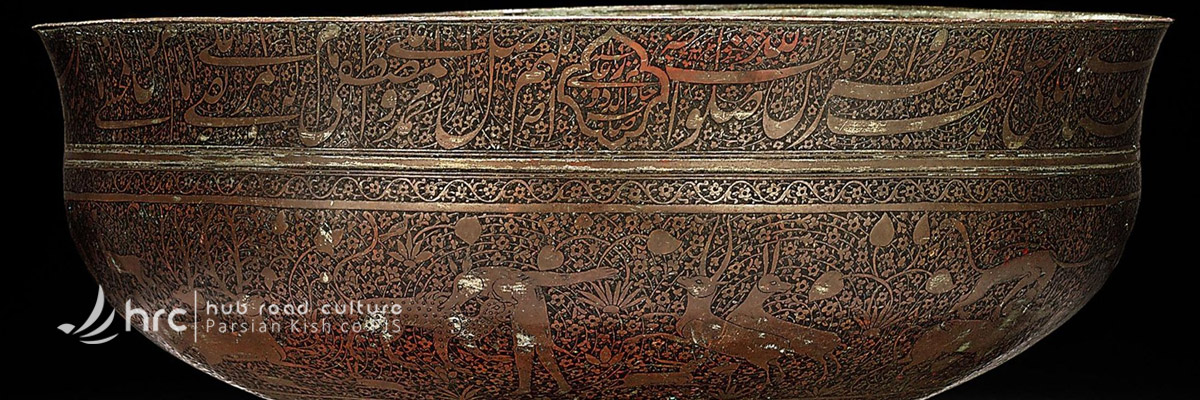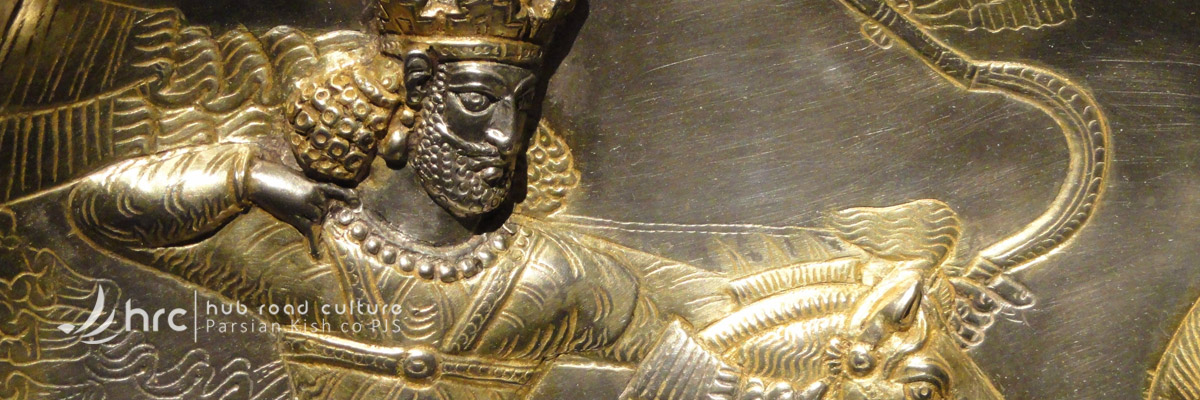Iranian Metalwork
Metalwork is perhaps the most continuous and best-documented artistic medium from Iran in the Islamic period, which survives mainly in brass and bronze. Most gold and silver wares, better known through literary accounts, were likely melted down. At times, echoing the forms of more ephemeral or less costly materials such as ceramics, metalwork from Iran and adjacent lands served a wide variety of utilitarian functions. These were nonetheless luxury wares that absorbed the creative energy of some of the best artists and reflected the main artistic trends and the tastes of successive dynasties.

Documenting sources
Written sources are an important means of documenting Iranian Metalwork. In addition to literary works and primarily geographical texts in Arabic and Persian, which provide information on centers of production and sources of metal ores, the objects themselves often supply internal documentation through their inscriptions. Iranian metalwork is therefore an important resource for understanding Iran Art in the Islamic Period in particular and the history of Islamic Art in general.
Early Islamic metalwork
Silver and gold plate, especially the former, provide a well-documented art form in Sasanian Iran and in pre-Islamic era of West Central Asia. Sasanian silver vessels (bowls, dishes, …), often decorated with imperial symbolism such as the royal hunt (Harper and Meyers), must have appealed to the new Muslim rulers, who sought to emulate the traditions of Persian kingship. This can explain the existence of a large group of mainly silver gilt objects that continue and readapt the Sasanian style which characterized simply as “post-Sasanian”; the issue of their provenance and dating remains uncertain.As the new Islamic polity asserted control over Iran and the territories to its east, many of the same metalwork forms and techniques continued to develop and evolve, while much of the representational imagery gradually lost its original meaning. It seems likely that objects fashioned of both silver and gold persisted as status symbols for the new aristocracy. It is often difficult to pinpoint where Sasanian art ends and Islamic art begins in the first centuries of Muslim rule. The situation with contemporary base metal is similar, but these objects also stand more obviously in a definable relationship to Islamic art. The stylization and abstraction of the decoration and the proliferation of repetitive surface decoration are singular features of Islamic art.

Medieval metalwork
Although the mechanism for transmission is not always clear, it is apparent that Jaziran and Syro-Egyptian metalwork of this period also benefited from as well as contributed to the development of Iranian Metalwork.Sometime toward the middle of the 12th century, the metalwork industry in Iran underwent a major transformation that was to be of signal importance for its history. Bronze and brass objects, some of them copying shapes in precious metal, were inlaid with silver and copper or gold. At roughly the same time, hammered brass began to replace cast brass in the manufacture of luxury metal-ware. Khorasan has long been recognized as the center for the production of these wares. Khorasanian inlaid wares are notable for the wide variety and virtuosity of their shapes: faceted or fluted ewers, candlesticks whose bulging sides are defined by rows of hexagons worked in relief, and circular inkwells surmounted by melon-shaped dome-like covers. Their largely figural decoration is likewise wide-ranging, including scenes of pleasure and pastime, astrological symbols, zoomorphic inscriptions, and plastically rendered figures of animals, especially lions and birds.
Some of the figural scenes are as ambitious as contemporary painting. Their inscriptions provide the first extensive evidence of royal patronage of base metal ware inlaid with gold and silver.
Late medieval metalwork
By the end of the 14th century, following Timur’s invasion of Iran during the last decade of the century, the focus of royal patronage, including metalwork, shifted eastward, first to western Central Asia and then to Khorasan. A distinctively Timurid style of Iranian Metalwork emerged by the second quarter of the 15th century and continued into the 16th century, documented by some twenty-five signed and/or dated objects. A larger group can likewise be attributed to Khorasan in the 15th-16th centuries by analogy with the signed and dated wares.Only a few wares can be attributed to western Iran in the late 14th and early 15th century. These demonstrate that the metalworking centers in Fars and Azerbaijan continued to work in the manner established earlier. Iranian Metalwork from the first decades of the 16th century under the Safavid dynasty continued the forms, techniques, and styles that had evolved in the preceding century in eastern Iran. Such wares can only be distinguished from earlier Timurid examples on the basis of the dates or the content of their inscriptions.

Iranian Metalwork Production at the first Safavid capital Tabriz is attested by three cylindrical, dome-covered inlaid inkwells, all signed by the artist Mirak Huseyn Yazdi and documented in contemporary manuscript illustrations from Tabriz. In the second quarter of the 16th century the decoration became stiffer and more schematized. This transitional style is found primarily on engraved and tinned wares. Several objects demonstrate the arrival of a new style of metalwork in western Iran around the third quarter of the 16th century. This novel aesthetic is characterized by sleek, tapered forms, while engraved (non-inlaid) figurative decoration reappeared but remained less important.The shapes and decorative vocabularied form continued into the early 17th century under Shah Abbas I. Such engraved pieces occasionally bear Armenian inscriptions alongside the more common Persian verses; they probably belonged to members of the Armenian community established by Shah Abbas in New Julfa.
The style associated with the reign of Shah Abbas lasted throughout the 17th century, as demonstrated by several objects. Some engraved and tinned wares dateable to the late 16th century or the early 17th century have been ascribed to Khorasan, as their inscribed owners’ names include references to places in that region. They are decorated with the same type of abstract and figural ornament found on objects from western Iran, but the design is organized in a more spacious manner and always includes cross-hatching. The dates and attributions for many later 16th- and 17th-century wares are open to question. In contrast to the 15th- and 16th-century pieces, their inscriptions often supply the name of the owner but rarely contain artists’ signatures or clues to the provenance.

Early modern metalwork
Thousands of pieces of Iranian Metalwork produced under the Zand and Qajar dynasties have survived, but they are of modest merit, generally utilitarian brass and copperwares with the exception of some fine examples of cut-steel, including copies after 17th-century pieces.
Splendid Handicraft
It’s now clear that how much this old land is so rich in handicrafts, all mirrorring its whole mysterious history and culture. Among colorful handicrafts, Iranian Metalwork is perhaps the best-documented of all; in which, one can see the glorious history of Iran carved on the surface of metal by artist hands of Iranian people.

